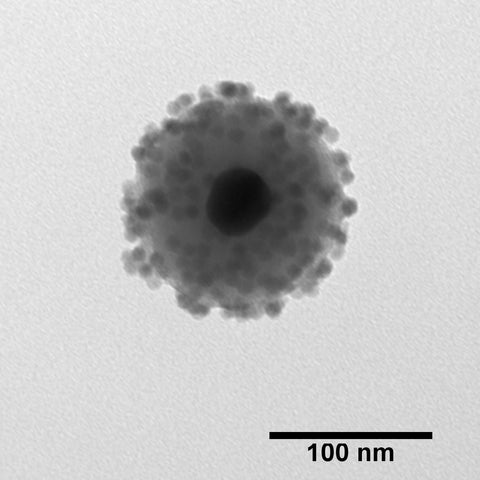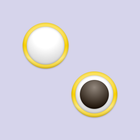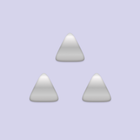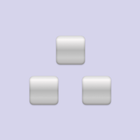Nanomaterials exhibit a variety of unusual and interesting optical properties that can differ significantly from the properties exhibited by the same bulk material. By carefully controlling the size, shape and surface functionality of nanoparticles a wide range of optical effects can generated with many useful applications. An optical response in a nanomaterial can be created through several different mechanisms, depending on the nanomaterial size, composition and arrangement, and each method may provide certain benefits depending on the target application.
This module contains a brief summary of the various mechanisms that influence nanoparticle optical properties.
Scattering, Absorption and Extinction
When light is incident on a nanoparticle, it can be scattered or absorbed (the sum of scattering and absorption is referred to as extinction). Nanoparticles are in the size regime where the fraction of light that is scattered or absorbed can vary greatly depending on the particle diameter. At diameters less than 20 nm, nearly all of the extinction is due to absorption. At sizes above 100 nm, the extinction is mostly due to scattering. By designing a particle with a larger or smaller diameter, the optimal amount of scattering and absorption can be achieved. Another byproduct of this relationship between size and absorption/scattering is that aggregation can increase the effective size of a nanoparticle resulting in an increase in scattering. This is why 20 nm diameter silica particles are clear in solution but re-suspensions of dried 20 nm silica particles (aggregated) will be a milky white color.
Plasmonic Nanomaterials
Nanoscale structures made of metals such as gold, silver and aluminum can support surface plasmon modes where the free electrons in the material naturally resonate at a frequency that depends on the composition, size and shape of the particle. When the wavelength of incident light matches the oscillation frequency, the particles can strongly absorb or scatter the light resulting in a strongly colored particle. By tuning the size and shape, the peak resonance wavelength can be shifted across the visible and into the infrared region of the spectrum allowing for a wide range of color tunability.

In addition to metal nanoparticles, there have been recent examples of metal oxide nanoparticles doped with other metal atoms that show strong and tunable plasmon resonances. By changing the particle size, dopant and dopant concentration, plasmon resonances in the near-infrared (NIR) and short-wavelength infrared (SWIR) have been fabricated.
For more information on plasmonic materials, their properties, and applications, continue on to our NCXU course on The Science of Plasmonics.
Quantum Dots
Nanoparticles made of semiconductor materials, often referred to as quantum dots (QD), absorb and emit light at certain wavelengths that depend strongly on particle size and shape due to quantum confinement effects. By changing the size and composition of the quantum dots, their emission wavelengths can be tuned from the UV through the visible to the near infrared regions of the spectrum. For example, by tuning the size of CdSe QDs from 2 nm to 8 nm in diameter, the emission wavelength can be shifted across the visible spectrum, with the smaller particles emitting in the blue and the larger particles emitting red light.
As fluorescent materials, quantum dots offer a number of advantages over organic fluorescent dyes: in addition to the ability to easily tune optical properties by varying particle size, the QDs are less prone to photobleaching under high intensity illumination, offer comparable or larger quantum yields than organic dyes, and can be excited much further away from their emission peak, giving them a large effective Stokes shift and allowing more flexibility with imaging or choosing excitation sources to avoid auto-fluorescence in biological samples.
QDs are used in a variety of applications including photodetectors, solar cells, light emitting diodes (LEDs), televisions, and for medical imaging. At nanoComposix we use QDs as components of multi-functional particles – typically for diagnostics and imaging. An example is a metal cored quantum dot composite particle that is used in lateral flow diagnostic devices.

Photonic Crystals
Another method of generating color is by organizing nanoparticles into ordered structures, with structural elements similar in size to the wavelength of light. These structures can selectively reflect certain portions of the spectrum, producing films with optical responses that can be tuned by selecting the size of the component particles.
This type of “structural color” has many examples in nature, such as the iridescent blue appearance of a morpho butterfly wing, which is due to nanoscale periodic structures that reflect only blue wavelengths of light. Structural color is gives rise to the multi-colored iridescence of opal gemstones, which are made from highly ordered assemblies of silica particles.
Our highly monodisperse nanoparticles can be used for the assembly of colloidal crystals where dried particles will organize into a periodic assembly that can diffract light. Structural color assemblies can also be created dynamically in solution using magnetically-responsive particles, such as the particles shown below which align into ordered structures in the presence of a magnetic field.
Additional Resources
Recommended Literature
- Willets, K. A., & Van Duyne, R. P. "Localized surface plasmon resonance spectroscopy and sensing." Annual Review of Physical Chemistry, 58, 267-297 (2007)
- Smith, A. M., & Nie, S. “Semiconductor nanocrystals: structure, properties, and band gap engineering.” Accounts of Chemical Research, 43(2), 190-200 (2010).
- Zhao, Y., Xie, Z., Gu, H., Zhu, C., & Gu, Z. “Bio-inspired variable structural color materials.” Chemical Society Reviews, 41(8), 3297-3317 (2012).




